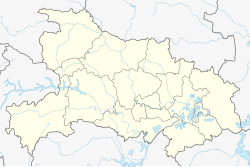
Back Xiangyang Afrikaans شيانغيانغ Arabic شيانجيانج ARZ শিয়াংইয়াং Bengali/Bangla Xiangyang Catalan Siŏng-iòng CDO Xiangyang (kapital sa prepektura) CEB Siang-jang Czech Xiangyang Welsh Xiangfan Danish
Xiangyang
襄阳市 Siangyang, Siang-yang | |
|---|---|
 | |
 Location of Xiangyang City jurisdiction in Hubei | |
| Coordinates (Xiangyang municipal government): 32°00′36″N 112°07′19″E / 32.010°N 112.122°E | |
| Country | People's Republic of China |
| Province | Hubei |
| County-level divisions | 8 |
| Township-level divisions | 159 |
| Municipal seat | Xiangcheng District |
| Government | |
| • Mayor | Qie Yingcai |
| Area | |
| 19,724.41 km2 (7,615.64 sq mi) | |
| • Urban | 3,672.9 km2 (1,418.1 sq mi) |
| • Metro | 3,672.9 km2 (1,418.1 sq mi) |
| Elevation | 71 m (232 ft) |
| Population (2020 census)[1] | |
| 5,260,951 | |
| • Density | 270/km2 (690/sq mi) |
| • Urban | 2,319,640 |
| • Urban density | 630/km2 (1,600/sq mi) |
| • Metro | 2,319,640 |
| • Metro density | 630/km2 (1,600/sq mi) |
| GDP[2] | |
| • Prefecture-level city | CN¥ 338.2 billion US$ 54.3 billion |
| • Per capita | CN¥ 60,319 US$ 9,684 |
| Time zone | UTC+8 (China Standard) |
| Area code | 710 |
| ISO 3166 code | CN-HB-06 |
| License Plate Prefix | 鄂F |
| Website | xiangyang |
| Xiangyang | |||||||||
|---|---|---|---|---|---|---|---|---|---|
 "Xiangyang" written in Chinese | |||||||||
| Simplified Chinese | 襄阳 | ||||||||
| Traditional Chinese | 襄陽 | ||||||||
| Postal | Siangyang | ||||||||
| |||||||||
| Xiangfan | |||||||||
|---|---|---|---|---|---|---|---|---|---|
 | |||||||||
| Chinese | 襄樊 | ||||||||
| Postal | Siangfan | ||||||||
| |||||||||
Xiangyang is the second-largest prefecture-level city by population in northwestern Hubei province, China. It was known as Xiangfan from 1950 to 2010.[3] The Han River runs through Xiangyang's centre and divides the city north–south. The city itself is an agglomeration of two once separate cities: Fancheng and Xiangyang (or Xiangcheng), and was known as Xiangfan before 2010. What remains of old Xiangyang is located south of the Han River and contains one of the oldest still-intact city walls in China, while Fancheng is located to the north of the Han River. Both cities served prominent historical roles in both ancient and pre-modern Chinese history. Today, the city has been a target of government and private investment as the country seeks to urbanize and develop the interior provinces. Its built-up area made up of 3 urban districts had 2,319,640 inhabitants at the 2020 census while the whole municipality contained approximately 5,260,951 people.
- ^ "China: Húbĕi (Prefectures, Cities, Districts and Counties) - Population Statistics, Charts and Map". www.citypopulation.de. Archived from the original on 5 March 2016. Retrieved 5 April 2018.
- ^ 湖北省统计局、国家统计局湖北调查总队 (August 2016). 《湖北统计年鉴-2016》. China Statistics Press. ISBN 978-7-5037-7847-6. Archived from the original on 2017-03-01. Retrieved 2017-06-05.
- ^ 湖北省襄樊市更名为襄阳市(图). 163.com (in Chinese (China)). 2010-12-02. Archived from the original on 2015-01-10. Retrieved 2010-12-03.
